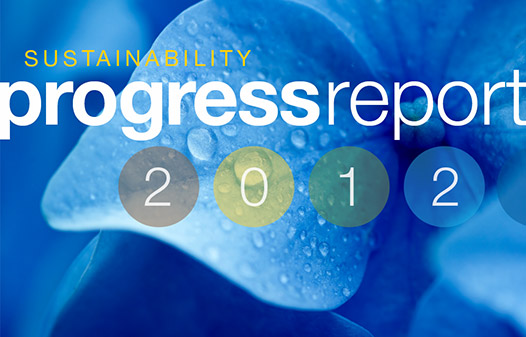by John Ball
THE UNIVERSITY OF Michigan is showing a positive impact on sustainability as highlighted in the university’s 2014 sustainability report released last week. However, even with the gains, U-M’s efforts to divert trash from landfills, among other goals, still lag far behind both the City of Ann Arbor, as well as colleges in Michigan and around the country.
“This work is vital to leaving future generations an environment that has the same potential to support life and economic activity as the one we inherited,” U-M President Dr. Mark Schlissel said.
In the world of waste and recycling, the term “diversion rate” is used to express how much waste is diverted from the landfill. In most cases, the waste is either recycled or composted instead.
However, with a 29 percent recycling diversion rate, a rate which has risen 9 percent over the past half a dozen years, U-M continues to send tens of thousands of tonnes of recyclable materials to landfills every year. UC-Berkleley’s recycling diversion rate, according to that college’s 2014 sustainability report, is 62 percent. At Pepperdine University only 22 percent of the waste produced at that school ever makes it to a landfill. The other 78 percent is recycled, an enviable diversion rate for any college campus or city.
College football stadiums can produce as much as 50 tonnes of recyclables in a single season. In 2014, 91 college football programs signed up for a sustainability contest called the Game Day Challenge. While U-M has the largest football stadium in the county, Michigan was not among the 91 colleges which took the challenge. In total, eight Big 10 college football stadiums implemented programs to improve recycling, minimize waste, reduce greenhouse gases and use organics.
The University of Minnesota’s football stadium ended up with a 78.1 percent diversion rate, landing its efforts among the top ten of the 91 schools which competed in the Game Day Challenge. At Clemson University’s football stadium, over 30 tonnes of recyclables were diverted from the landfill during the 2014 season.
While U-M’s recycling diversion rate rose 9 percent between 2008 and 2014, at the University of Maryland, that institution’s recycling diversion rate rose from 17 percent is 2003 to 78 percent in 2014, according to the college’s sustainability report.
Colorado College is targeting a 90 percent waste diversion rate by 2020.
Arizona State University published a Strategic Plan for Sustainability Practices in 2011 that declared zero waste as a primary goal for on-campus sustainability efforts. ASU pledged to eliminate 90 percent of campus solid waste from the landfill by 2015. U-M’s target is a 40 percent diversion rate by 2025, according to the 2014 sustainability report.
Although the university has experienced success toward meeting its goals, it also has seen challenges, said Andy Berki, manager of the Office of Campus Sustainability.
“The university is taking a closer look at its current efforts in areas that have been slow to see progress, including greenhouse gas reduction, waste reduction and campus culture,” he said. “Working groups of faculty, staff and students are meeting monthly to evaluate existing efforts, with recommendations for new actions and approaches expected by the end of this academic year.”
U-M is diverting a notable percentage of construction materials after building projects conclude, at the high rate of 80 percent.
According to the 2014 report, U-M Grounds Services crews were able to reduce use of land management chemicals by 54 percent, the lowest since 2006, while continued conservation efforts by Energy Management resulted in an 8 percent overall reduction in energy consumption in 137 buildings. In addition, U-M President Mark Schlissel joined the ever-growing community of Planet Blue Ambassadors—more than 1,700 strong—in their commitment to living more sustainably.
U-M recently introduced a new minor on sustainable food systems through the College of Literature, Science, and the Arts.
The college launched a $1.6 million federally funded, nationwide study by researchers at the National Center for Geospatial Medicine, based at the School of Natural Resources and Environment, exploring potential social and environmental links to autism.
Faculty work under MCubed seeks to understand the emergence of locally-owned food businesses in Detroit, as well as their connection to urban farming activities, city revitalization and community wellness.
U-M created “Mcity,” a 32-acre, mini-city located on North Campus designed for testing connected and automated vehicle systems and other emerging 21st-century smart city technologies.
In addition, the U-M saved an estimated $1.5 million in energy costs as a result of sustainable practices in 800 laboratories, equivalent to the amount of energy needed to power 800 U.S. homes for a year.
Using environmental metrics, the university tracks the impact of its operations and measures progress toward long-range goals focused on climate, waste prevention, healthy environments and community awareness.
Operations data in the report shows the following movement toward the 2025 sustainability goals:
Goal: Cut U-M greenhouse gas emissions by 25 percent.
Status: Emission levels have increased; 28 percent decrease needed.
Goal: Decrease vehicle carbon output on passenger trips by 30 percent.
Status: On track. Reduced vehicle carbon output by 13.5 percent.
Goal: Shrink the amount of waste sent to landfills by 40 percent.
Status: Waste levels decreased; 35 percent decrease currently needed.
Goal: Protect the Huron River through stormwater-control strategies and apply 40 percent less chemicals to campus landscapes.
Status: Completed. Reduced chemical application by 54 percent.
Goal: Purchase 20 percent of U-M food from local and sustainable sources.
Status: On track. Currently purchasing 12.2 percent of U-M food from local and sustainable sources.
In 2014, U-M eliminated the inclusion of soda beverages and bottled water from its Sustainable Food Purchasing Guidelines, resulting in a drop in progress toward the sustainable food purchase goal. The new guidelines align more closely with those established by the Association for the Advancement of Sustainability in Higher Education’s Sustainability Tracking Assessment and Rating System and used by peer institutions.

